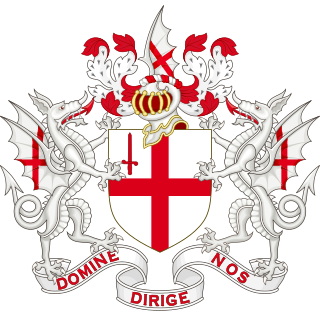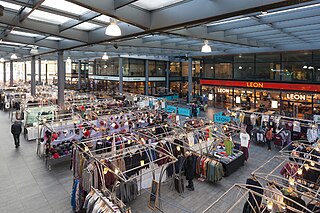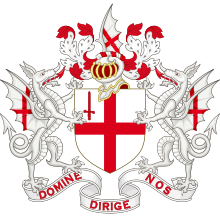
The City of London, widely referred to simply as the City, is a city, ceremonial county and local government district that contains the ancient centre, and constitutes, along with Canary Wharf, the primary central business district (CBD) of London and one of the leading financial centres of the world. It constituted most of London from its settlement by the Romans in the 1st century AD to the Middle Ages, but the modern area referred to as London has since grown far beyond the City of London boundary. The City is now only a small part of the metropolis of Greater London, though it remains a notable part of central London. The City of London is not one of the London boroughs, a status reserved for the other 32 districts. It is also a separate ceremonial county, being an enclave surrounded by Greater London, and is the smallest ceremonial county in England.

Smithfield, properly known as West Smithfield, is a district located in Central London, part of Farringdon Without, the most westerly ward of the City of London, England.

The City of London Corporation, officially and legally the Mayor and Commonalty and Citizens of the City of London, is the municipal governing body of the City of London, the historic centre of London and the location of much of the United Kingdom's financial sector.

Sir Horace Jones was an English architect particularly noted for his work as architect and surveyor to the City of London from 1864 until his death. He served as president of the Royal Institute of British Architects from 1882 until 1884, and was knighted in 1886. His most recognised work, Tower Bridge, was completed posthumously.

Billingsgate Fish Market is located in Poplar in London. It is the United Kingdom's largest inland fish market. It takes its name from Billingsgate, a ward in the south-east corner of the City of London, where the riverside market was originally established. In its original location in the 19th century, Billingsgate was the largest fish market in the world.

New Spitalfields Market is a fruit and vegetable market on a 31-acre (13 ha) site in Leyton, London Borough of Waltham Forest in East London. The market is owned and administered by the City of London Corporation. The market is Europe's leading horticultural market specialising in exotic fruit and vegetables - and the largest revenue earning wholesale market in the UK.

Leadenhall Market is a covered market in London, England, located on Gracechurch Street but with vehicular access also available via Whittington Avenue to the north and Lime Street to the south and east, and additional pedestrian access via a number of narrow passageways.

Old Spitalfields Market is a covered market in Spitalfields, London. There has been a market on the site for over 350 years. In 1991 it gave its name to New Spitalfields Market in Leyton, where fruit and vegetables are now traded. In 2005, a regeneration programme resulted in the new public spaces: Bishops Square and Crispin Place, which are now part of the modern Spitalfields Market. A range of public markets runs daily, with independent local stores and restaurants - as well as new office developments.
A money market fund is an open-end mutual fund that invests in short-term debt securities such as US Treasury bills and commercial paper. Money market funds are managed with the goal of maintaining a highly stable asset value through liquid investments, while paying income to investors in the form of dividends. Although they are not insured against loss, actual losses have been quite rare in practice.
Net asset value (NAV) is the value of an entity's assets minus the value of its liabilities, often in relation to open-end, mutual funds, hedge funds, and venture capital funds. Shares of such funds registered with the U.S. Securities and Exchange Commission are usually bought and redeemed at their net asset value. It is also a key figure with regard to hedge funds and venture capital funds when calculating the value of the underlying investments in these funds by investors. This may also be the same as the book value or the equity value of a business. Net asset value may represent the value of the total equity, or it may be divided by the number of shares outstanding held by investors, thereby representing the net asset value per share.

A custodian bank, or simply custodian, is a specialized financial institution responsible for providing securities services. It provides post-trade services and solutions for asset owners, asset managers, banks and broker-dealers. It is not engaged in "traditional" commercial or consumer/retail banking like lending.

Northern Trust Corporation is an American financial services company headquartered in Chicago, Illinois that caters to corporations, institutional investors, and ultra high net worth individuals. Northern Trust is one of the largest banking institutions in the United States and one of the oldest banks in continuous operation. As of June 30, 2022, it had $1.7 trillion in assets under management and $17 trillion in assets under custody. Northern Trust Corporation is incorporated in Delaware.

Fund accounting is an accounting system for recording resources whose use has been limited by the donor, grant authority, governing agency, or other individuals or organisations or by law. It emphasizes accountability rather than profitability, and is used by Nonprofit organizations and by governments. In this method, a fund consists of a self-balancing set of accounts and each are reported as either unrestricted, temporarily restricted or permanently restricted based on the provider-imposed restrictions.

Dagenham Dock is an industrial district in the London Borough of Barking and Dagenham in London, England. It is located to the south of Dagenham and is on the River Thames. It was once the site of a large coaling port and continues to be the location of a small terminal licensed to handle coal off-loading. Today the site is used for a number of river-related operations including a 25-acre (100,000 m2) TDG depot with around 200 tanks for the storage of petrol, distillates, aviation fuel, biofuels, tallow, ethanol, fertilisers, and urea.

Charterhouse Street is a street on the north side of Smithfield in the City of London. The road forms part of the City’s boundary with the neighbouring London Boroughs of Islington and Camden. It connects Charterhouse Square and Holborn Circus, crossing Farringdon Road and running along a number of historical sites, including Smithfield Market.

Langbourn is one of the 25 ancient wards of the City of London. It reputedly is named after a buried stream in the vicinity.

Alberta Investment Management Corporation (AIMCo) is a Canadian Crown corporation and institutional investor established to manage several public funds and pensions headquartered in Edmonton, Alberta. AIMCo was established by an act of the Legislative Assembly of Alberta in 2008 under the government of Progressive Conservative Premier Ed Stelmach.

Spitalfields Market is a traders' market as well as a food and art market located in Spitalfields, Central London. Traders began operating around 1666, after the Great Fire of London, where the market stands today. The Spitalfields regeneration programme that ended in 2005, resulted in two new public spaces – Bishops Square and Crispin Place, which restored several historic streets and resulted in more independent retailers and restaurants. Spitalfields Market is situated in the London Borough of Tower Hamlets. It is surrounded by Lamb Street, Old Spitalfields market, Brushfield Street and Bishops Square.
The City of London market constabularies are three small constabularies responsible for security at Billingsgate, New Spitalfields and Smithfield markets run by the City of London Corporation.
















